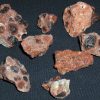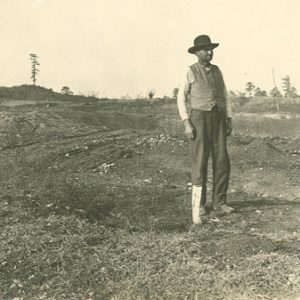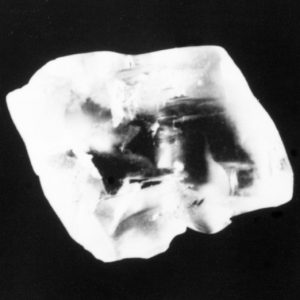calsfoundation@cals.org
Official State Gem
aka: Diamond
On February 22, 1967, Governor Winthrop Rockefeller signed Act 128, an omnibus measure designating the diamond as the state gem, quartz crystal as the state mineral, and bauxite as the state rock. The measure, introduced in the Senate by Robert Harvey, J. Hugh Lookadoo, and Olen Hendrix, called attention to Arkansas’s status as one of the few places in North America where diamonds are present in their host rock and the only such place where tourists may hunt for them. The diamonds are recovered from the Prairie Creek diamondiferous pipe, a roughly triangular surface outcrop exposed over thirty-seven acres situated two and a half miles southeast of Murfreesboro (Pike County). The site is a breccia-filled volcanic pipe formed during the Cretaceous period by a series of gaseous explosions, as are several other pipes nearby. Geologists have known of the site since 1842.
Diamond, composed of densely packed carbon, is the hardest known substance on earth. It has unique physical and chemical properties, aside from its brilliance and “fire” when faceted into a gemstone, which make it important to industrialized society. Industrial-grade diamond powders often are used to cut and polish gem-grade stones. Other uses include surgical blades, glass cutting and engraving tools, wiredrawing dies, metal cutting tools, and drill bits.
Diamonds were discovered in Arkansas in 1906 when farmer John Huddleston picked up two such stones near the mouth of Prairie Creek southeast of Murfreesboro. After this, diamonds were reported from two small areas two miles northeast of the Prairie Creek pipe. These discoveries created a modest local sensation: the 1913 design of the Arkansas flag included a horizontally oriented rhombus or stylized diamond shape inspired by the Prairie Creek pipe’s bounty. Several efforts were made in the first half of the twentieth century to mine Arkansas diamonds commercially, without sustained success. The development in the 1950s of man-made diamonds suitable for industrial purposes probably sealed the fate of Arkansas’s prospects as a diamond-mining powerhouse.
This did not preclude a different sort of development. After World War II, the failed commercial mining operations became a privately run tourist attraction. The volcanic pipe and some surrounding acreage became Crater of Diamonds State Park in 1972 when the state bought the property for $750,000. The possibility of unearthing gem-quality stones has inspired a steady draw of visitors to this unorthodox attraction: nearly 2.3 million guests visited the park from 1972 to 2005. The enduring popularity of this attraction is memorialized in the 2003 Arkansas commemorative quarter, which bears a representation of a diamond, depicted in a side view of a round brilliant cut.
Recovery figures are incomplete, but an estimated 100,000 diamonds, thought to average 0.25 carats, have been recovered from the Prairie Creek pipe by commercial efforts and tourists. Since the site became a state park, the state has maintained records of the number of diamonds discovered and reported. From 1972 to 2005, 25,369 diamonds weighing a total of 4,954.41 carats have been reported. The largest known stone discovered and reported during this period is a 16.37-carat white diamond unearthed in 1975 by a Texan, though earlier, in 1923, a diamond weighing 40.23 carats was unearthed.
For additional information:
Bassoo, Roy Raymond, Jr. “Guiana Shield Diamonds, the Sub-Cratonic Lithosphere, and Kimberlite Emplacement in the Upper Crust.” PhD diss., Baylor University, 2021.
Crater of Diamonds State Park. http://www.craterofdiamondsstatepark.com/ (accessed August 3, 2023).
Howard, J. Michael. Finding Diamonds in Arkansas. Little Rock: Arkansas Geological Commission, 1989.
Millar, Howard. It Was Finders Keepers at America’s Only Diamond Mine. New York: Carlton Press, 1976.
Ware, David. It’s Official! The Real Stories behind Arkansas’s State Symbols. 2nd ed. Little Rock: Butler Center Books, 2017.
Worthington, Glenn W. A Thorough and Accurate History of Genuine Diamonds in Arkansas. Murfreesboro, AR: Mid-America Prospecting, 2003.
David Ware
Arkansas Secretary of State’s Office

 Crater of Diamonds
Crater of Diamonds  Robert Harvey
Robert Harvey  Olen Hendrix
Olen Hendrix  John Huddleston and Sam Reyburn
John Huddleston and Sam Reyburn  Uncle Sam Diamond Rough
Uncle Sam Diamond Rough 




Comments
No comments on this entry yet.